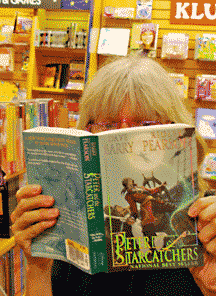 |
||||||||||||||||
|
||||||||||||||||
|
||||||||||||||||
Bay Weekly’s Annual Summer
|
||||||||||||||||
 |
photo by Heather Boughey |
Our Old Man of the Bay, 35 years the Evening Sun’s outdoors editor; Bay Weekly columnist for 14 years and counting.
So many books, so little time.
So many books, even without novels. I’m not one for novels written since Vladimir Nabokov and D.H. Lawrence put down their pens.
For the past several years, I’ve made it a point during the summer to read at least one book appropriate for the time; last year it was Al Gore’s Inconvenient Truth.
This year it’s T.E. Lawrence, a 252-page biography by Desmond Stewart chronicling the life of an exciting World War I hero.
Which prompts the question of appropriateness of the times.
Sure, Lawrence of Arabia was of a bygone era. But the lands then tagged as Arabia and the people known as Arabs, Kurds, Muslims remain pretty much the same, as do those of the Ottoman Empire.
With war in Iraq still underway, the reader is enlightened about the geography of the Middle East, its people and their way of life. Only a young lieutenant in the British Army, T.E. Lawrence united the Arabs, leading their forces in the fight against the Turks; his victories and personal heroics are legendary.
His personal life remains shrouded in mystique, his premature death a mystery.
You’ll find many books in the library about T.E. Lawrence, including his autobiography Seven Pillars of Wisdom (it will take you to next summer to finish it) and Lowell Thomas’s Lawrence of Arabia. With both, you have to sort fact from fiction, but they’re fascinating and enlightening.
Steve Carr
Bicyclist, sailor, hasher; author of Waterviews (with Marion Warren and Eric Smith); environmental consultant; Bay Weekly columnist.
Are you tired of sitting in traffic, watching houses sprout up like weeds on every piece of vacant woods while motels and golf courses spread like cancer across the Chesapeake’s fragile wetlands? Well then, grab a comfy beach chair and start reading Carl Hiaasen.
Hiaasen is an award-winning investigative journalist and columnist for The Miami Herald. He has written about eight books chronicling the destruction of Florida’s wetlands, endangered species and cultural social fabric. Each book catalogues in almost hallucinogenic detail, the corrupt and environmentally disastrous land-use policies of a state where everyone else in the country seemingly wants to live.
It’s hard to pick my favorite Hiaasen novels, any more than I could pick my favorite pistachio nut. As long as there’s another book to read, I’m there.
I especially like Strip Tease, about a sexually deviant U.S. congressman; a strip club in Dade County filled with a wild assortment of tough girls who wrestle drunks in pasta and creamed corn; a seven-foot-tall, 300-pound, bumpy-headed, bald bouncer who reads Camus; and a cigar-smoking homicide detective from Miami who saves a Mensa stripper from her drug-crazed former husband, who steals wheelchairs for a living.
If you like hair-raisingly crazy plots where the villains end up getting killed by nine irons or marauding crabs, then Carl Hiaasen is just the ticket to make you forget about why Maryland seems so loony.
Dotty Holcomb Doherty
Mother of teenage daughters and wife of a craftsman, chef and National Park Service planner, Dotty Holcomb Doherty spends her time writing, birdwatching, walking the woods and kayaking the Bay.
Sara Gruen’s 2006 novel Water for Elephants sets a complex love story in the midst of a Depression-era train circus. Many dream of joining the circus; remember Toby Tyler and his side-kick chimp Mr. Stubbs? But Gruen’s tale is no Disney movie.
Told by aging Jacob Jankowski, the story opens with a murder, a secret he has kept for 70 years. From his nursing home wheelchair, Jankowski remembers the days when another tragedy left him alone and penniless; when he jumped a train and joined the struggling Benzini Brothers Most Spectacular Show on Earth.
Vivid writing evokes great characters, including an enigmatic elephant with a propensity for gin, a tough dwarf who loves a Jack Russell terrier and Jankowski himself, whose loyalties cast him into continual danger.
Whisked through backlots and scrambling atop moving train cars, you’ll smell the reek of cat and the sweat of the roustabouts as you enter these hardscrabble lives. This fast-paced tale tips on the edge of horror, sweeping you into the sinister dealings of an unscrupulous ringmaster and the terrible web woven between the dashing but mean-spirited equestrian director and his pixie wife, who steals both the show and Jankowski’s heart with her daring and beauty.
Begin this book when time stretches ahead of you: a vacation or a weekend when the lawn can wait. Once you enter the vortex of this novel, prepare to stay.
Jane Elkin
Bay Weekly theater reviewer and Renaissance woman who lives and kayaks in Cape St. Claire.
If you think T.B. on a plane is scary, imagine an even more deadly disease. Think bubonic plague. Ring around the rosy, we all fall down. If you also think airport security is tight, imagine a public health police state. Think diagnostic computers so invasive they leave nothing to the imagination.
Now if you think either of these nightmares would make for a compelling novel, imagine them rolled together into a thriller that is part historical fiction and part science fiction, set in both Medieval Europe and the near future. The Plague Tales, by Ann Benson, is guaranteed to cause sleep deprivation from the first page to the last. This, her first novel, is also her best in my opinion. It interweaves history, sociology, herbalism, alchemy, witchcraft and medical archaeology into a mystery that appeals to many tastes on some level.
When she wrote the book in 1997, her vision of 2005 seemed just a bit far fetched. Not any more. Since the advent of a government agency devoted solely to national security, it all seems chillingly possible. But don’t be turned off by the heavy subject matter. This is a surprisingly light read that will also make you laugh.
M.L. Faunce
Award-winning and longtime Bay Weekly contributor and fancier of Dachshunds; prefers her Martini stirred and not shaken.
A small hardbound copy of the Bartender’s Bible kicked around my parents’ home for years. From it, the only concoction ever mixed to my memory was whiskey sours at Christmas. With the recent publication of The Joy of Drinking by Barbara Holland, I revisited not only libations fit for a summer evening on the Bay, or a winter day by the fire, but a cocktail mix of both history and humor to get us through both.
Barbara Holland is a trip. In this slim volume, she covers tales of potions as remedies for all that ails, intoxicating discoveries from Marco Polo to Captain Cook to Mark Anthony and island cultures living the soused life. Holland, who is known to tipple daily, deducts that “drink is the glue of the human race.” Who’s to argue? Beer is the cornerstone of civilization according to Holland. William Faulkner, she notes, observed that “civilization begins with fermentation.” She then instructs us in the chemical process.
In this slim volume you will learn to make your own applejack. But most of all, you will begin to appreciate not the culture of booze but the loss of joy that has come along with the decline of social drinking, and the time set aside of an evening to enjoy the cheer of human companionship and spirits. Have this one on Barbara Holland.
Guy Guthridge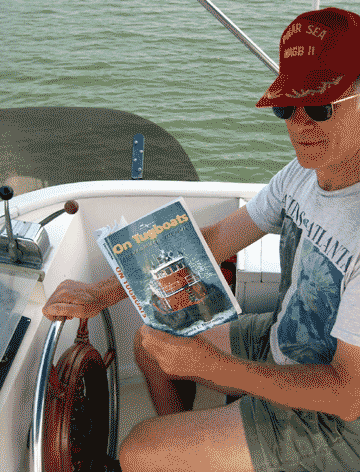
After a career in the National Science Foundation’s United States Antarctic Program, co-writing a book about scientific research and the Bay.
I didn’t think about tugboats much.
Then, in Baltimore, two tugs subtly nudged the ends of a ship I was on until it gently touched the pier. They whistled their shrill codes of stop and go.
I laughed and remembered Little Toot.
And I remembered that a tugboat had saved Solomons Island from fire by hosing a burning restaurant.
And I read Virginia L. Thorndike’s with-it On Tugboats: Stories of Work and Life Aboard. “There’s an appealing element of David and Goliath,” she writes, “about a tugboat with its charge.”
The tugs are various: harbor tugs, ocean tugs, tugs that pull and those that push.
But the book is mainly about people: deckhands and masters and situations they get into. “Things can get tense every time a tug comes near something, intentional or otherwise,” she writes.
Thorndike spent a lot of time on the boats, more with the people who bring the book alive. “The tales they tell are not unique,” she writes. Rather, she says, they are typical of tugboaters. Memorable, poignant and funny.
The book showed me an author and people who love tugs —- and life perhaps more. When I got to the last page, I wanted to head to a portside bar and listen to tugboaters.
 |
photo by Mike Mullican |
Petey Kitzmiller
Bay Weekly advertising account manager; grew up on and around the Chesapeake Bay and sails with her father Mike on the Different Drummer, a wooden 37-foot Dickerson ketch.
Where and how we, humankind, and our world came to be what we now are has always fascinated me. No science or history will ever offer the full and final answer, and I eagerly let old knowledge slide away when new knowledge appears. Charles C. Mann’s 1491: New Revelations of the America before Columbus (2006) and Paul Schneider’s Brutal Journey: The Epic Story of the First Crossing of North America, are just the sort of books I love. Both address the time in North America just before and into the beginning of the European conquest.
A thrilling adventure story, Schneider’s Brutal Journey relates from original journals and records the first in-depth exploration of the New World shortly after Cortés. The expedition began in 1528 with 400 men and ended eight years later with four survivors walking into a Spanish outpost nearly 5,000 miles from where they started. Schneider deftly compares their reports of who they met and what the world of pre-European North America was like with other first person accounts from in-country adventurers and old-world government records and diaries, clarifying where the survivor reports might be slanted toward eliciting patronage or validating their bizarre trials in their struggle to survive and get back to their old world.
1491: New Revelations of the America before Columbus presents much of the latest historical, anthropological and archeological thinking on what was here before the European invasion. Rather than isolated hunter-gatherer tribes living close to the land, Native Americans had extensive, agricultural-based, socially and economically complex societies with huge populations. Europeans and their livestock brought disease that raced ahead of their advance. In some areas, 95 percent of the original residents were dead — having never seen a European. That means one out of 20 survived. Europeans walked into a world ravaged by a holocaust. The serene Indians in touch with nature were actually desperate and fragmented people, scavenging amidst the forests and fields that grew up and over their town, villages, croplands and orchards.
J. Alex Knoll
Before co-founding New Bay Times in 1993, Bay Weekly general manager J. Alex Knoll worked two seasons as mate on a Chesapeake crab boat, where a couple bushels of menhaden bait often translated to dozens of bushels of legal crabs.
When the Pilgrims landed at Plymouth Rock, their goal was to establish a profitable fishing company. Yet they arrived with no fishing gear or expertise and would have starved to death that first year without the aid of the Wampanoag Indians. The Wampanoag taught them not only to fish, but also to plant with each seed of corn a foul-smelling, oily, bone-filled fish.
So began America’s relationship with menhaden, also called pogies, bunker, moss-bunkers and alewifes. In The Most Important Fish in the Sea (2007), H. Bruce Franklin chronicles the long history these unappealing and seemingly inexhaustible fish have played in our country.
By the time of America’s independence, farmers from Maine to Rhode Island were revitalizing their nutrient-poor soil with menhaden they caught themselves. But with industrialization came industrialized fishing and the menhaden reduction industry. The fish were caught in massive numbers, and the oil and solids from the fish were reduced to make lamp oil and commercial fertilizer. Fortunes were made as fleets scoured New England’s waters, and processing plants dotted its shores. But by the Civil War, the fishery in these northern waters was dead and had moved south, beginning a long boom-and-bust, boom-and-bust cycle that has left much of the Atlantic Coast bereft of menhaden.
Today, the menhaden reduction industry survives only in Virginia’s portion of Chesapeake Bay and the Gulf of Mexico, with spotter planes directing huge fishing vessels to the fish. Then, two smaller boats are launched to surround the school with a surface-to-bottom net, capturing everything in its path. Once unloaded, the fish are reduced, pulverized into oil — which finds its way into everything from fertilizer to makeup to margarine — and meal, which is used to make livestock and pet food.
For decades, commercial and sports fishermen have lambasted the effect the menhaden reduction industry has had on larger feeder fish.
Only recently, however, has science discovered the other role these fish serve. Like oysters, menhaden are filter feeders; they swim in massive schools, slurping up zooplankton, phytoplankton and other water-borne particulates — the very crud that has clouded our once-clear waterways, causing algae blooms, red tides and dead zones.
“If a healthy person needs a fully functioning liver,” Franklin writes, “consider someone whose body is subjected to unusual amounts of toxins — just like our Atlantic and Gulf coasts. If menhaden are the liver of these waters, should we continue to allow huge chunks to be cut out each year, cooked into industrial oils, and ground up to be fed to chickens, pigs and pets?”
Bill Lambrecht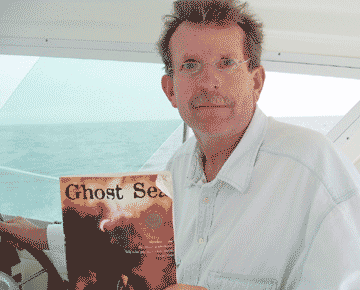
Writer, writer, writer: author of two books, Dinner at the New Gene Cafe; Big Muddy Blues; Washington Bureau Chief, St. Louis Post-Dispatch; Bay Weekly cofounder and editorial analyst.
A year ago, I vowed in these pages to catch up with the French novelists who had eluded me back when I was having too much fun: Proust, Stendhal, those fellows. I made it through Gustave Flaubert’s Salammbo and got bored.
But I just finished something of note by a Hungarian-born novelist, Ferenc Maté, that has what was missing in those French books: adventure. Ghost Sea, published last year by W.W. Norton, is a seagoing adventure story reminiscent of Joseph Conrad but not as dense. It’s about a rogue sailboat captain named Dugger working the British Columbia coast a century or so ago — until he lands hopelessly in a forbidden love affair with the wife of a wealthy artifacts collector.
By artifacts, we’re talking about masks, native cultural items and the like, goods indigenous people in the region begin to miss. In retaliation, a Kwakiutl warrior kidnaps the collector’s wife, leading the sailboat captain on a rescue mission, where he and the crew of his ketch encounter storms, magic, treachery, murder and worse.
Ghost Sea is gripping and painstakingly researched with a twisting plot that will leave you wondering if you really read what you just read. And unlike reading some of those French novels, you won’t feel like you just sat in a literature seminar for two hours.
Valerie Lester
 |
photo by Jim Lester |
World traveler; Bay Weekly contributor; author of Phiz, The Man Who Drew Dickens and Fasten Your Seat Belts! History and Heroism in the Pan Am Cabin; still at work on a modern novel with classical undertones.
Last year, I read Elliot Perlman’s Seven Types of Ambiguity, which takes its title from William Empson’s famous literary tretise of earlier days and names its leading dog Empson in a tribute to the philosopher. This year, I read Elliot Perlman’s Three Dollars, and I highly recommend both for your summer reading. (There’s a third, The Reasons I Won’t be Coming, which came out first, and I bet it’s good, too.)
Perlman is a philosopher masquerading as an Australian lawyer and novelist, and Seven Types of Ambiguity is an intellectual blockbuster and suspense story. It is told in the individual voices of seven people involved in the same incident where the central character kidnaps (or does he?) his ex-girlfriend’s son. As each character comes to grips with the truth — and here the reader, too, must ponder the nature of truth — Perlman, in his wry and wiry prose, ratchets up tension and complexity. He is, at one and the same time, modern, Victorian, edgy, concise, digressive and utterly engaging.
Three Dollars is less ambitious but nonetheless engaging. It concerns the struggle for morality in a world that constantly undermines it. Perlman portrays his hero’s journey from hapless youth to unsuccessful man, describing relationships along the way that ring true as a bell. The tension builds unbearably, but even at the end, when all seems lost, hope waves a tiny banner.
Sonia Linebaugh
Bay Weekly’s most persistent contributor; artist, reader and writer; Bay advocate.
Susanna Clarke’s 2004 novel Jonathan Strange and Mr. Norrell is more than heat relief, though it will fool you into believing that you are shivering in damp English libraries, parlors and byways in 1806. Not just the atmosphere will chill you, but also the compelling characters who connive to bring about a resurgence of magic. To start, Mr. Norrell causes the statues of York Cathedral to sing and speak. Next, a young woman is raised from the dead with consequences that blight more than one life. Jonathan Strange goes from Norrell’s student to his competitor to … best not to tell.
“All magicians lie, and this one more than most,” says one of the book’s characters. In a world of political intrigue and clashing egos, backed up by spells and counter spells, that means practically everyone. This dense world of light and shadow will convince you that it once existed. Copious footnotes prove it. When you stagger away from the 782 pages, you’ll want a long cold drink and a sequel.
Tom Lyons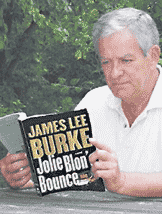
New this summer to Bay Weekly; retired to Edgewater after careers in the St. Louis Metropolitan Police Dept. and on Wall Street buying and selling bonds.
James Lee Burke’s novels are the perfect summer fare if you like crime mixed with exquisite lyrical prose. This is polished prose and graceful writing at its best.
Burke has been described as the “Faulkner of crime fiction” and the “Graham Green of the Bayou.” His characters are painfully flawed, human in their frailty and superhuman in their efforts to survive. Violence bursts from placid waters in the bayou. Unspeakable evil disguised as righteousness, sharp contrasting human behavior and profound layers of deception focus our attention, almost imploring the reader to slow down and savor the richness of Burke’s prose.
Nothing is as it seems: the powerful extractive oil industry deceiving the small landowner; the greedy, self-righteous politician homegrown like sugarcane; frightening weather patterns turning into rainbows dressing up a languid landscape.
Burke’s novels can be page turners, but take your time; it is summer, after all. Here’s a short list to get you started: Jolie Blon’s Bounce, Burning Angel, Sunset Limited and, for you Civil War buffs, White Doves At Morning.
Carrie Madren
Bay Weekly staff writer; summer reader; explorer of local parks, trails and green spaces; wife of nine months.
Lose yourself in Nick Bantock’s savory The Forgetting Room. Bantock, who created the wonderful Griffin & Sabine trilogy, takes us to Ronda, Spain, where we travel with Armon Hurt to the home of his recently deceased grandfather.
As Armon denies his grief and struggles with his feelings of place, he explores the attic in his grandfather Rafael’s house. Discovering a series of clues left for him by his grandfather, Armon digs deep into memory. The clues lead him to create a collage of images that unravel mysteries about himself, his family and ultimately his life’s direction.
The truly lovely part of this book is its marriage of art and intrigue. A spellbinding story emerges in Rafael’s studio. Throughout the book, you’ll encounter colorful, lavish designs, artwork and images — some of which actually fold out into your reading space. These tangible images full of mystical clues open in your hands, making you feel as desperate as Armon to unravel the mysteries.
Helena Mann-Melnitchenko
Frequent Bay Weekly contributor; memoirist and eclectic reader in several languages.
The Memory Keeper’s Daughter, 50 weeks on the bestseller list, is a multifaceted gem of a novel by Kim Edwards. It’s a finely cut amethyst, deep, dark but with flashes of light. The writing is superb.
Family secrets, a marriage overwhelmed by an unspeakable lie, an ancient grief and an immediate one make this a haunting book.
It’s 1964. A doctor delivering his twins in a snowstorm tells his wife that one of them has died. He hands his Down’s syndrome daughter to his nurse to be placed in a home for the disabled. The nurse cannot part with the child.
At the heart of the novel lies the lie and the abyss it creates within the family.
Although this is a first novel for Edwards, she has been recognized for her short story collection, The Secrets of the Fire King.
For a second, a writer recognized throughout his long life has penned a short but thought-provoking novel. In Everyman, Philip Roth encapsulates the life of a selfish unnamed man.
It opens with his funeral and ends with his death. In its center, Roth illuminates everyman’s losing battle with mortality: the deterioration of the body, the search for meaning and the judging of one’s life as it nears its end. The hero, of course, is Shakespeare’s “conqueror worm.”
Sandra Olivetti Martin
Bay Weekly cofounder and editor; life-long book reader, hungry for plot and plots; time-and-a-half journalist; spare-time book editor.
One must buy books one’s friends have written, reflected writer and contributor Elisavietta Ritchie (Another Year Older, Another Trip to the Dump: Vol. xv, No. 22: May 31). Which is how The Fourth Horseman came to my home and hand. Author Robert Koenig, an old colleague of my husband’s in the Washington Bureau of the St. Louis Post-Dispatch, has crafted a story amazing at several levels. On the first, The Fourth Horseman (2006) is a tale of espionage and dangerous adventure. On another, a timely look at the 20th century origins of germ warfare. The antihero to whom Koenig gives that Revelatory title is Anton Dilger, a Virginia-born, second-generation German American, a saboteur who brewed anthrax in his Chevy Chase basement.
On other levels, The Fourth Horseman is an eye-opening look at skipped-over chapters of our heritage. On our way to becoming a melting pot, America seethed with ethnic loyalties. No surprise, but understood with new clarity on reading this book, is the role ethnics — Germans here — played in waging, avoiding and declaring war, from the Civil War through World War II. And who would have imagined how many horses it took to fight wars, up through World War I?
I also read books written by other reporters. Thus, on the heels of The Fourth Horseman came to hand military reporter Ed Offley’s Scorpion Down (2007). This one, too, has lots of levels, starting with a dramatic submarine mystery (I love a good submarine story). Offley tells you in the first sentence how the nuclear submarine Scorpion was lost on a May day in 1968: This is the last thing they heard in their closed world: the faint scree-scree-scree of the incoming torpedo…
This book continues as a two-decade masterpiece of investigative reporting uncovering the story behind the story concocted by the Pentagon to cover up Scorpion’s true fate. Along the way to that conclusion, you’ll learn all you never knew you wanted to know about how (and why) submarines are built, deployed, operated and lived in.
Ben Miller
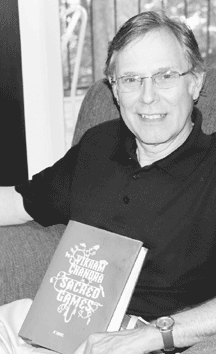 |
photo by Cathy Conway Miller |
Museum reviewer and contributing writer for Bay Weekly; interested in nature and American history; yoga practitioner; visitor to Bombay (but not the one he read about).
For a big, thick novel of a place and people few of us know, read Sacred Games by Vikram Chandra. Set in today’s sprawling and vibrant Mumbai (Bombay), India, Sacred Games features a middle-aged police officer, an ambitious Indian gangster and a cast of believable characters both good and bad, all oddly sympathetic in their humanity.
Following a tradition of detective stories, Sartej Singh is world weary, lonely and, as a Sikh in a largely Hindu police force, an outsider. He is investigating murder, blackmail, the mysterious connections of Ganesh Gaitonde, a dead mobster — and worse. Contemplating threatened nuclear terrorists, he says We are here, and we will stay here. Perhaps … the people of Bombay would stay in their city even if they knew that a great fire was coming. Perhaps they would wait for the bomb in these tangled lanes, grown out of the earth without forethought or plan.
Gaitonde dies early in the book yet continues to tell the story of his violent life. There is plenty of violence — and foul language, too. The obscenities, creative and extensive, don’t sound so bad if you don’t know Hindi and other Indian languages. If you’re curious, the words, along with other Indian expressions and song lyrics, are translated in a glossary in the back of the book.
This is not the spiritual India we know through yoga — movies seem more important than religion — but religion is there, if under the surface, part of the rich and pulsating world that Chandra skillfully depicts.
Cathy Conway Miller
Teacher, photographer and contributor to Bay Weekly; reader of books featuring strong women.
Alexander McCall Smith’s Blue Shoes and Happiness is a fascinating, heartening summer read that also opens a window into another culture: modern-day Botswana. Seventh in the No. 1 Ladies’ Detective Agency series, this delightful novel stands on its own. It follows the adventures of Precious Ramotswe, a feisty woman “of traditional build.”
Armed only with a copy of Clovis Andersen’s The Principles of Private Detection and a great deal of common sense, scarcely a day goes by without her encountering some problem people had brought upon themselves.
McCall Smith gets into the mind of a woman with whom we can identify and appreciate in her complexity, wisdom and humor. The series’ ongoing characters, including her ultra-efficient assistant, Mma Makutsi, are similarly believable and fun. There is pleasure in following these compelling characters throughout the series. We come to anticipate their reactions like those of old friends. We root for them and rejoice in their successes.
As we celebrate our national day of independence, you’ll also find Mma Ramotsw an exemplar of patriotism: Her heart could still fill with love for that Africa she once knew, our mother, she thought, our mother who is always with us, to provide for us, to nourish us, and then to take us, at the end, into her bosom.
If this is your first book in the series, you’re in for a treat.
 |
photo by Clyde Farnsworth |
Elisavietta Ritchie
Recent Bay Weekly contributor; fiction president, Washington Writers’ Publishing House; has published 14 collections of poetry and fiction.
One book for summer reading? But I’m a magpie! I don’t read just one book, write one story at a time, though editing a book-manuscript gets my full attention. My bedside table supports compelling books, not non-stop page-turners. These tomes demand I read a page, turn back and reread.
All essential multi-seasonal readings. Not for the beach: tide might swipe them.
Audiobooks are great while driving even before NPR drifts off. While entranced, I almost veer off the road. Recent favorites: Barbara Kingsolver’s Bean Trees, Prodigal Summer, Animal Dreams and Poisonwood Bible. Her rich language, magnificent metaphors, envelop us in particular locales whether Kentucky mountains, southwest U.S. Indian country, Georgia, the Congo. Her landscapes play their own roles as, confronting environmental, societal and familial challenges, multifaceted characters choose their own paths.
Equally lush: Toni Morrison. Song of Solomon I read long ago, but I recently discovered Sula. Her warm muddy river of a vibrant parallel society washed over me, drowning me in richness. Morrison studied Faulkner, whom I’ve rediscovered via Audiobooks.
Now I’m again hooked on Annie Proulx. We read Shipping News aloud during cold rainy Newfoundland: both the book and Newfoundland’s reality resemble the Bay’s estuarine societies, climates and landscapes. Each chapter begins with the instructions for a different sailor’s knot more complicated than those I memorized at age 14. Proulx’s lonely characters are as complex as the knots.
Proulx’s terrain in Close Range: Wyoming Stories is as exotic as Mongolia and as overwhelming. I gulped her story Brokeback Mountain, now a separate chapbook, spinoff of the film I haven’t seen; not everyone’s cup of whiskey, but I couldn’t put it down. Traveling, we’re listening to another of her collections: That Old Ace in the Hole, then home to read more of Close Range. So I’m currently lost in Wyoming, in Proulx’s eccentric characters and small, startling or shocking incidents in a landscape that only seems empty.
Lynn Teo Simarski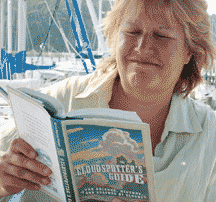
Saw her most compelling clouds over Antarctica’s Mount Erebus; Science writer, now writing about Chesapeake science.
A sailor told me I have a “weather eye,” which means able to sense foul weather: a useful attribute when you live aboard a boat like I do, but for me, a modest and more intuitive than educated skill. Thus I combed Gavin Pretor-Pinney’s Cloudspotter’s Guide: The Science, History, and Culture of Clouds for a more systematic grounding to serve as on-board Cassandra.
The book offers some of that and more: clouds in art, clouds that changed history, clouds that inspired ancient Christian symbols and UFO sightings. Above all, clouds are nature’s most egalitarian display, their beauty visible to all.
Cumulonimbus is the book’s showstopper cloud. We are ejected into a thunderhead over Norfolk, Virginia, with pilot William Rankin, who parachuted into complete darkness, was pelted with hailstones, tossed like a piece of popcorn and forced to hold his breath to keep from drowning (he survived the descent). His cloud type is at the heart of every one of some 40,000 thunderstorms worldwide every day.
For beauty, nothing rivals the epical Morning Glory, the cloudspotter’s holy grail. Glider pilots journey to Australia’s outback to surf the majestic rolling cloud like an enormous wave.
As for prediction, even our newest clouds — manmade contrails — can be read for weather clues: When these jet trails spread out in the sky, rain may be in store. The book reminds us that clouds are good for inner weather too: “Clouds are for dreamers, and their contemplation benefits the soul.”
Alice Snively
Bay Weekly’s Gunk-Holin’ columnist; sailor, journalist and grandmother, lives with husband aboard the 43-foot Columbia Cherokee II.
Not being an area native, I discovered the work of homeboy John Barth only recently, and a delightful find it’s been. True American literature is in short supply, but this award-winning writer helps keep the art alive. Among my favorite Barth works is The Last Voyage of Somebody the Sailor. It’s a wonderful blend of Chesapeake Bay boy-through-manhood mythos and time-warped fantasy adventures with Sindbad and company from the 1001 Arabian Nights.
This is summer reading at its best, weaving together familiar Bay themes and earthy, fun, romantic, lustful, imaginings of the life of Sindbad’s daughter, Scheherazade, in the golden days of the monsters and mysteries of Araby. This book is most definitely only for adult reading. There’s quite a bit of sex in it, but these interludes are critical to the story and written with candor and valuable insight.
While this is a work of fun and fantasy, it’s also imbued with life experiences, some of which may feel somehow familiar. And there is wisdom in its pages that moved me at least to quiet reflection through the seas of emotion, yet left me feeling wonderfully alive and grateful to be so.

Aubree Stafford
lives in Shady Side with her husband, Brad. Her last feature for Bay Weekly was There’s More Than the Tailgate to the Marlborough Hunt Races (Vol. XV, No. 14). This summer, she’ll succumb to the Harry Potter craze, with plans to read the entire series.
As the sticky summer months descend upon Chesapeake Country, you need a novel equally oozing heat and humidity. Theodore Dreiser’s 1920’s novel, An American Tragedy, juggles themes of greed, obsession and murder, all culminating in a court case to rival even your favorite Law and Order episode.
Dreiser takes the typical boy-meets-girl scenario and spins steamy twists and turns, all dripping with desire for the things we can’t have. A chance encounter with a wealthy uncle transplants then-hotel bellhop Clyde Griffiths to St. Louis, where he grasps at the rungs on the social ladder that remains just outside his reach.
Lonely poor boy meets lonely poor girl. Clyde seems content at Griffiths Collar & Shirt Company and in his romance with factory-worker Roberta — until life wealth and social status are dangled just within his reach. A society beauty falls for Clyde and the upper class beckons him into the American dream. Grasping his dream proves more difficult, and soon Clyde descends to the depths of his psyche to make his dream into his reality.
 |
photo by Mike Mullican |
Michelle Steel
Bay Weekly contributor; former Montessori teacher; avid reader; naturalist; mother of two sons.
Barack Obama searches for his roots and his identity in Dreams from My Father. Obama, the son of a black African father and a white American mother, seeks meaning to his life as a black American. His journey begins in New York, after hearing the news that his father has been killed in a car accident. He travels to Kansas to trace the migration of his mother’s family to Hawaii; then to Kenya, to meet the African side of his family.
In Dreams, Obama openly talks about racism, loss of innocence and his own personal demons (his flirtations with drugs and alcohol). Much of the book is based on family oral histories, allowing you a more intimate glimpse into his life. In Part Three, titled “Kenya,” you journey alongside him and his sister Auma, on safari through the Great Rift Valley, learning about Masai legends and beliefs, wondering what lies around the next corner.
And Obama, belonging to two different worlds yet ultimately belonging to neither, awakens us to problems that still exist in our century.
“There is not a Black America and White America and Latino America and Asian America — there’s the United States of America,“ Barack Obama concludes.
If Dreams from My Father leaves you wanting more, check out The Audacity of Hope, which captures Obama’s thoughts on reclaiming the American Dream.
Margaret Tearman
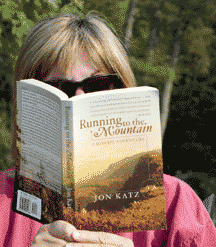 |
photo by Tom Tearman |
Bay Weekly staff writer; lives in Calvert County with her husband and three dogs.
Will he be killed by a bolt of lightning? Or run over by a train? Or will the mice living in his basement simply devour him?
I turn page after page for the answers.
In Running to the Mountain, the precursor to his better known books, A Dog Year and The Dogs of Bedlam Farm, Jon Katz takes readers on his candid, mid-life journey from New Jersey where he shared a soft, suburban existence with a wife and daughter, to a rundown house on a mountain in upstate New York.
Accompanied only by his two Labrador retrievers, Julius and Stanley, and the literary works of Thomas Merton, Katz embarks on his self-imposed solitary adventure. When finally alone on the mountain, away from the wife and daughter he adores, Katz tackles the decrepit house, its resident rodents, rural eccentricities — and his personal demons.
I had trouble making long-distance phone calls. Every time I dialed home, an operator came on. When I set up my PowerBook the operator’s interruptions meant I couldn’t dial up the Internet. I realized something was wrong and called Bell Atlantic.
The service rep could barely keep from laughing.
“Don’t you know?” she said. “You’re on a four-way party line.”
Dick Wilson
 |
photo by Ellie Girsany |
Dedicated, world-traveling Scuba diver; and longtime Bay Weekly proofreader and contributor of tales.
In the not-too-distant past, people in the Cayman Islands (in the Caribbean, south of Cuba) made their livings by hunting green turtles. This is a story about their world.
And a hard world it was. Under threat of hurricane, always in danger of fetching up on some submerged reef, they plied their trade in old boats to which the term seaworthy could not be accurately applied.
Peter Mathiessen wrote Far Tortuga in an unusual style, almost entirely in dialogue, in Caribbean island dialect, without quotation marks and without attribution. The reader always knows who is speaking, however, because the characters are so strongly drawn that every utterance announces the speaker’s identity.
The dialogue is not an obstacle for the persistent reader who will soon be immersed. It’s a delight to know the characters so well that in your mind you hear them and see them as they speak.
The unusual style is not the book’s only strength. The progress of the boat, its failings and misadventures, the humanity of the characters all make this a great read. As an added bonus, you get a map to follow the boat’s progress around the Caribbean cays.

Bill Wohlfeld
Recently minted Bay Weekly writer and former Senior Correspondent with the Observer Newspapers (VA). Spouse of Eleanor, artist, and father of two daughters.
I don’t read books often. I prefer to listen to them and bond with the author and narrator. Instead of the one-dimensional printed page, I listen to the spoken text through the marvel of audio books. Narrators are often talented actors who bring the printed page to life.
Catch the Whisper of the Wind is a magical book that takes the listener into the mythical spirit and philosophies of American Indian tribes. The author, Cheewa James, of Modoc Indian descent, narrates timeless wisdom, accompanied by haunting native music. Though largely of the past, many of the sayings relate to our lifestyles, mixed with humor: Marriage among my people was like traveling in a canoe. The man sat in front and paddled the canoe. The woman sat in the stern but she steered. All this comes as a double treat; a cassette and a book, so you can enjoy a mix of the senses, visual and audio.
My second summer sampler takes a turn from the mythical to the macabre in Edgar Allan Poe’s Tales of Terror. Narrator Jack Foreman adds special horror to Poe’s tales of suspense. Nine short stories include the ever-popular “The Pit and the Pendulum” and “The Tell-Tale Heart.” Turn out the lights while listening for an extra scary treat.
Happy listening!
Special thanks to Mike Mullican for photos in this anthology.
|
Current Issue \\ Archives \\ Subscriptions \\ Clasified Advertising \\ Display Advertising |
© COPYRIGHT 2007 by New Bay Enterprises, Inc. All rights reserved.



